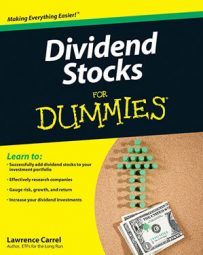To determine whether a stock is underpriced or expensive, the relative dividend yield (RDY) strategy compares a stock’s yield to the dividend yield of the broader market.
RDY isn’t a good strategy for those seeking instant gratification. It’s a long-term strategy of three to five years that doesn’t rely on past earnings, forecasted earnings, or P/E ratios to determine valuations.
The relative dividend yield approach encourages investors to be patient, disciplined, independent, contrarian investors who move against the crowd by focusing on large companies that have experienced trouble but are familiar, well-known businesses stable enough to eventually recover. Using absolute yield to identify undervalued stocks can leave you in a lot of mature, slow-growth industries.
RDY investors want capital appreciation as well as income. Because the yield on a RDY stock doesn’t need to be very high (just higher than the market), it helps identify good values in both weak and strong markets. Using RDY over the long term provides a portfolio with a higher stream of income, a 1.5 to 2 percent better total return, and a lower risk than the S&P 500 index does.
The RDY reflects investor sentiment. According to Spare, a high RDY indicates despair in the market, whereas a low RDY signals investor enthusiasm. Following the relative dividend yield strategy, you buy when other investors are selling and sell when other investors are buying. This strategy’s followers expect the following:
High yield: All RDY stocks have higher than average yields. RDY investors don’t buy a stock until its yield is typically at least 50 percent higher than the market. By looking at yield, RDY identifies undervalued stocks, which are expected to eventually see capital gains in terms of price. Still, the high yield likely represents a significant amount of the investor’s returns.
Low risk: RDY stocks have lower risk than the rest of the market because they’re neglected stocks. When RDY identifies a potential candidate, the stock has already been beaten down and underperformed the market for some time. Because the stock’s share price has already seen a significant drop, it’s less likely to fall farther.
Long holding periods: The typical holding period for an RDY stock is three to five years. When the stock’s share price recovers and moves higher, it causes the stock’s relative yield to drop below the market’s yield, creating the sell signal.
Low turnover: Holding stocks for longer periods means you sell only about a quarter to a third of the portfolio in a given year, compared to a 100 percent turnover at most mutual funds. Low turnover leads to lower transaction costs, leaving more money to be invested and generating better returns. In addition, fewer sales means fewer capital gains realized in any given year, which leads to a lower tax bill.
Less volatility: Because RDY portfolios hold mostly large, mature companies with a reputation for paying consistent dividends, these stocks don’t fall as much as the broader market in bear markets or stay down as long.
RDY gives you buy and sell signals based on yield. This strategy seems a bit more complicated than the dividend connection, which uses absolute yield. Absolute yield looks at a company’s yield alone, independent of other variables, for buy signals.

